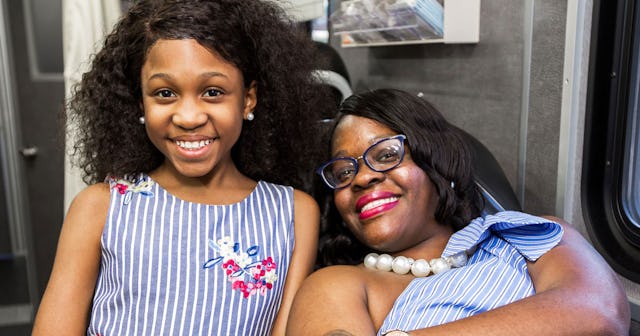My Child Was Diagnosed With A Sickle Cell Disease

I sat in the doctor’s office in my last trimester, filled with fear, concern, and exasperation.
This appointment would reveal whether my daughter would have sickle cell disease.
I had prayed that she wouldn’t have this painful disease, but I also knew it was a possibility since it runs in my family. I’ll never forget the look on my doctor’s face as he stepped closer and leaned in to confirm, “Your daughter has sickle cell disease.”
It was a very emotional time because we didn’t know what to expect. Learning that your unborn child will be affected by a chronic illness for the rest of her life is something a parent never wants to hear.
As I tried to cope with my anxiety and hurt after hearing the news, I made up my mind to use the few weeks before her arrival to learn about the different forms of sickle cell and how they impact the body.
Once Tymia was born, we found out that she had hemoglobin SS disease, which is the most common and severe form of sickle cell disease and causes individuals to experience the worst symptoms at a higher rate. She was only two months old when she was struck with dactylitis, a common first symptom of sickle cell disease. It blocks blood circulation, causes pain, and affects the bones of the hands and feet. This crisis would give way to many years of emergency visits to the hospital and overnight stays filled with terror and angst.
Sickle cell disease is an inherited blood disorder that affects as many as 100,000 people—90% of whom are of African descent. The disease causes red blood cells to change from a normal round, soft blood cell to a sticky, hard, sickle shaped cell under certain stressors that can be triggered by variables as random as the weather, not eating or drinking enough, or the slightest peak in stress.
These abnormal blood cells can then stick together and block blood flow and oxygen, causing a sickle cell crisis that brings on pain and other complications that can last from several hours to several days.
When my daughter suffers from a crisis it is the scariest thing. Her beautiful brown skin pales and she becomes lethargic, unable to move or speak.
Each sickle cell patient is different and the way the disease affects them varies, which makes it hard to predict treatment and anticipate needs until a crisis occurs. There is no widely available cure for sickle cell disease, so for now, we rely mostly on regular blood transfusions among other treatments to counter the harmful effects of the disease. At times, we have waited as long as 10 hours for blood to become available; once it arrives the four-hour transfusion process is like watching a miracle unfold before my eyes. Her complexion is restored; she begins to talk, smile, laugh, and she gains enough strength to move.
To date, Tymia has been hospitalized over 61 times, receiving more than 60 blood transfusions and multiple surgeries to help save her life.
As a mother, I must be strong for Tymia, but there are a lot of days that I look to my support group for added strength, encouragement, and reassurance that I am making all the right decisions for my daughter. I try not to be a burden, but there are so many emotions that I experience daily, that can only be calmed when I talk to my family and best friends.
Being Tymia’s mom has changed my world, how I view life, and what I stand for. I’ve become a strong advocate for my daughter and for others who have this debilitating disease. With my daughter by my side, I organize and host blood drives with the American Red Cross—thanking volunteer blood donors for their life-saving donations and helping to raise awareness on the importance of donating blood. We let these generous donors know that their blood donations help not just sickle cell patients, but others who may be in need because of illness or injury.
If I could share any advice with other moms who have a child with sickle cell disease, I would emphasize that they should learn about the disease and tell them not to be afraid of it or underestimate it because it is an uphill battle.
Sickle cell disease opens your eyes to a whole new world. For me, it was educating myself on the importance of blood and advocating for donors. Now that I understand how much sickle cell patients rely on donated blood I urge everyone to join me in becoming a blood donor. I’ve watched the generous donations of strangers give my child life and know how bad things can get during a crisis when blood products are not available. Tymia has suffered much longer than needed on two occasions because her blood type wasn’t available.
Please don’t wait until it’s a loved one who needs a blood transfusion—when emergencies arise patients with an immediate need rely heavily on donated blood already stocked on hospital shelves.
This article was originally published on